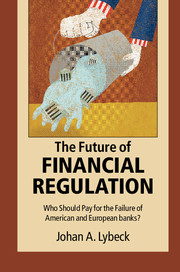Book contents
- Frontmatter
- Dedication
- Contents
- List of figures
- List of tables
- List of boxes
- Preface
- Acknowledgements
- List of abbreviations
- Introduction
- Part I A chronological presentation of crisis events January 2007 – December 2014
- Part II Bail-out and/or bail-in of banks in Europe: a country-by-country event study on those European countries which did not receive outside support
- Part III Bail-out and/or bail-in of banks in Europe: a country-by-country event study on those European countries which received IMF/EU support
- Part IV The TARP program and the bailing out (and bailing in) of US banks
- 13 The roles of the FDIC, the Treasury and the Fed in the crisis
- 14 USA: Bear Stearns, Merrill Lynch and Lehman Brothers
- 15 USA: Countrywide, IndyMac, Washington Mutual and Wachovia
- 16 USA: AIG, Citibank and Bank of America: zombies too big to fail?
- Part V Summary of the micro studies
- Part VI Political and regulatory responses to the crisis: to bail out or to bail in, that's the question
- Conclusion: toward host-country supervision and resolution?
- Addendum
- Bibliography
- Index
16 - USA: AIG, Citibank and Bank of America: zombies too big to fail?
from Part IV - The TARP program and the bailing out (and bailing in) of US banks
Published online by Cambridge University Press: 05 February 2016
- Frontmatter
- Dedication
- Contents
- List of figures
- List of tables
- List of boxes
- Preface
- Acknowledgements
- List of abbreviations
- Introduction
- Part I A chronological presentation of crisis events January 2007 – December 2014
- Part II Bail-out and/or bail-in of banks in Europe: a country-by-country event study on those European countries which did not receive outside support
- Part III Bail-out and/or bail-in of banks in Europe: a country-by-country event study on those European countries which received IMF/EU support
- Part IV The TARP program and the bailing out (and bailing in) of US banks
- 13 The roles of the FDIC, the Treasury and the Fed in the crisis
- 14 USA: Bear Stearns, Merrill Lynch and Lehman Brothers
- 15 USA: Countrywide, IndyMac, Washington Mutual and Wachovia
- 16 USA: AIG, Citibank and Bank of America: zombies too big to fail?
- Part V Summary of the micro studies
- Part VI Political and regulatory responses to the crisis: to bail out or to bail in, that's the question
- Conclusion: toward host-country supervision and resolution?
- Addendum
- Bibliography
- Index
Summary
Too big to fail
A too-big-to-fail firm is one whose size, complexity, interconnectedness and critical functions are such that, should the firm go unexpectedly into liquidation, the rest of the financial system and the economy would face severe adverse consequences. Governments provide support to too-big-to-fail firms in a crisis not out of favoritism or particular concern for the management, owners, or creditors of the firm, but because they recognize that the consequences for the broader economy of allowing a disorderly failure greatly outweigh the costs of avoiding the failure in some way. Common means of avoiding failure include facilitating a merger, providing credit, or injecting government capital, all of which protect at least some creditors who otherwise would have suffered losses (Ben S. Bernanke, chairman of the board of governors of the Federal Reserve System).
Which institutions are too big to fail (TBTF) and why? Big in terms of total assets or deposits is one thing. JPMorgan Chase would have had total assets of 3.7 trillion dollars at the end of 2012 rather than the stated 2.4 trillion had it reported under international IFRS standards rather than GAAP; Bank of America would have had assets of 3.1 trillion instead of 2.1 trillion, Citigroup 2.7 trillion instead of 1.9 trillion. They would have dominated the European giants: HSBC with total assets of 2.6 trillion, Deutsche Bank and Crédit Agricole 2.5 trillion, BNP Paribas and Barclays 2.4 trillion. It is, however, probably more relevant to ask, big in relationship to what? A number of alternatives open up: its home banking market or share of different markets, total world banking market, its home country's deposit insurance fund or GDP. In 2012, UBS had “only” 1.2 trillion dollars in total assets, a dwarf in relation to the giants cited above, but it was still 1.9 times Switzerland's GDP, whereas the largest American bank, JPMorgan Chase, at double the size of UBS “only” had assets corresponding to 23 percent of the GDP of the United States. Which is the more relevant figure? And what can be done about it?
In the terminology of the Basel Group's Financial Stability Board (FSB), these behemoths are called Globally Systemically Important Financial Institutions (G-SIFIs).
- Type
- Chapter
- Information
- The Future of Financial RegulationWho Should Pay for the Failure of American and European Banks?, pp. 358 - 388Publisher: Cambridge University PressPrint publication year: 2016



